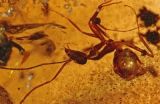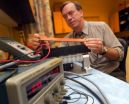(Press-News.org) Bees, termites, spiders, and flies entombed in a newly-excavated amber deposit are challenging the assumption that India was an isolated island-continent in the Early Eocene, or 52-50 million years ago. Arthropods found in the Cambay deposit from western India are not unique—as would be expected on an island—but rather have close evolutionary relationships with fossils from other continents. The amber is also the oldest evidence of a tropical broadleaf rainforest in Asia. The discovery is published this week in Proceedings of the National Academy of Sciences.
"We know India was isolated, but when and for precisely how long is unclear," says David Grimaldi, curator in the Division of Invertebrate Zoology at the American Museum of Natural History. "The biological evidence in the amber deposit shows that there was some biotic connection."
"The amber shows, similar to an old photo, what life looked like in India just before the collision with the Asian continent," says Jes Rust, professor of Invertebrate Paleontology at the Universität Bonn in Germany. "The insects trapped in the fossil resin cast a new light on the history of the sub-continent."
Amber from broadleaf trees is rare in the fossil record until the Tertiary, or after the dinosaurs went extinct. It was during this era that flowering plants rather than conifers began to dominate forests and developed the ecosystem that still straddles the equator today. The new amber, and amber from Colombia that is 10 million years older, indicates that tropical forests are older than previously thought.
In the research paper, Grimaldi, Rust, and colleagues describe the Cambay amber as the oldest evidence of tropical forests in Asia. The amber has been chemically linked to Dipterocarpaceae, a family of hardwood trees that currently makes up 80 percent of the forest canopy in Southeast Asia. Fossilized wood from this family was found as well, making this deposit the earliest record of these plants in India and showing that this family is nearly twice as old as was commonly believed. It most likely originated when portions of the southern supercontinent Gondwana were still connected.
Also reported in the paper are 100 arthropod species that represent 55 families and 14 orders. Some of these species are early relatives of highly social, or eusocial, insects like honey bees and stingless bees, rhinotermitid termites, and ants, suggesting that these groups radiated during or just prior to the early Eocene. And many of the Cambay fossils have relatives on other continents—although not where it would be expected. Rather than finding evolutionary ties to Africa and Madagascar, landmasses that India had most recently been linked to as part of Gondwana, the researchers found relatives in Northern Europe, Asia, Australia, and the Americas.
"What we found indicates that India was not completely isolated, even though the Cambay deposit dates from a time that precedes the slamming of India into Asia," says Michael Engel, a professor in the Department of Ecology and Evolutionary Biology and curator of entomology at the University of Kansas. "There might have been some linkages."
Climate might have also played a role in the fauna found in the Cambay amber. The Early Eocene was a time of great climatic warmth: the tropics reached the poles. The researchers predict that the climate would have had an effect on the distribution of arthropods.
"The Cambay Formation spans a period of great warmth which led to a profusion of tropical groups spread around the world," says Grimaldi. "The diversity and evolutionary relationships in the Cambay deposit show how profound an effect climate has on groups."
INFORMATION:
In addition to Grimaldi, Rust, and Engel, authors include Tom McCann, Frauke Gerdes, and Monica Solórzano-Kraemer of the Universität Bonn in Germany; Hukam Singh of Birbal Sahni Institute of Palaeobotany in India; Rajendra S. Rana and Lacham Singh of H.N.B. Garhwal University in India; Ken Anderson of Southern Illinois University in Carbondale; Nivedita Sarkar and Ashok Sahni of the University of Lucknow in India; Paul C. Nascimbene of the American Museum of Natural History; Jennifer C. Thomas of the University of Kansas; and Christopher J. Williams of Franklin and Marshall College in Pennsylvania. The research was funded in part by several organizations: American Museum of Natural History, U.S. National Science Foundation, National Geographic Society, and DFG (German Research Foundation).
New trove of fossils suggests global distribution of tropical forest ecosystems in the Eocene
Vast amber deposit from India described by international team
2010-10-26
ELSE PRESS RELEASES FROM THIS DATE:
Decoding the disease that perplexes: Salk scientists discover new target for MS
2010-10-26
LA JOLLA, CA-Scientists are closer to solving one of the many mysteries of multiple sclerosis and other demyelinating diseases, thanks to a recent study conducted at the Salk Institute for Biological Studies. The research revealed a previously unknown connection between two ion channels, which, when misaligned, can cause the many bizarre symptoms that characterize the condition.
The findings, reported in this week's online edition of the Proceedings of the National Academy of Sciences (PNAS), provide fresh insights into the mechanisms underlying MS and suggest a novel ...
Heart disease prevention program saves lives and reduces costs, Kaiser Permanente study finds
2010-10-26
DENVER — A new study from Kaiser Permanente Colorado is one of the first to show that an intensive population management program that matches heart disease patients to personal nurses and clinical pharmacy specialists not only reduces the risk of death but reduces health care costs as well.
The findings are published in the November issue of the journal Pharmacotherapy.
Researchers examined health care expenditures in two populations of patients with heart disease: a group of 628 people enrolled in the Kaiser Permanente Collaborative Cardiac Care Service, a population ...
New fog warning system in Venice region pays for itself 10 times over
2010-10-26
Fog is a relatively frequent phenomenon in the Po Valley and constitutes a major issue for all road traffic. The new fog warning system covers and benefits the entire Venice Region, combining VTT`s know-how on intelligent transport and evaluation of information services. The system is expected to provide services for regular and professional motorists and transport companies as well as authorities. These types of warning solutions are expected to be in demand on a larger scale in the future as they have positive safety effects and are very profitable socio-economically. ...
Scientists reveal the sex wars of the truffle grounds
2010-10-26
They are one of the most highly prized delicacies in the culinary world, but now scientists have discovered that black truffles are locked in a gender war for reproduction. The research, published in New Phytologist as the truffle season begins, represents a breakthrough in the understanding of truffle cultivation and distribution.
The teams, led by Dr Francesco Paolocci and Dr Andrea Rubini from the CNR Plant Genetics Institute in Perugia and by Dr Francis Martin from INRA in Nancy, carried out their research on the reproduction strategy of the highly prized black ...
Sleep disturbances show clear association with work disability
2010-10-26
Sleep disturbances increase the risk of work disability and may slow the return to work process. This is especially true in cases where work disability is due to mental disorders or musculoskeletal diseases. These results come from a recent study conducted by the Finnish Institute of Occupational Health in collaboration with the universities of Turku and London.
The research is being conducted as part of two major research projects on social capital in the workplace (Kunta10) and on well-being in the hospital workplace. The follow-up study is part of the Academy of Finland ...
Allergies and wheezing illnesses in childhood may be determined in the womb
2010-10-26
A child's chances of developing allergies or wheezing is related to how he or she grew at vital stages in the womb, according to scientists from the University of Southampton.
The new research, funded by the Medical Research Council (MRC) and the British Lung Foundation, and undertaken at Southampton General Hospital, reveals that fetuses which develop quickly in early pregnancy but falter later in pregnancy are likely to go on to develop allergies and asthma as children. Scientists believe this is due to changes in the development of their immune system and lungs.
A ...
Research on avoiding fraud in biometric identification
2010-10-26
The field that these researchers are working in is known by its nickname, "anti-spoofing", and basically consists in trying to detect all of the possible attempts at fraud that a biometric system might suffer, especially with regard to an action in which the user presents the biometric proof to the system. "What we are trying to do is detect those attempts so that the system can then act accordingly", explains the head of UC3M's Grupo Universitario de Tecnologías de Identificación (GUTI)(University Identification Technology Group), Raúl Sánchez Reíllo, who is leading this ...
Beauty from the bottom up
2010-10-26
Flamingos apply natural make-up to their feathers to stand out and attract mates, according to a new study by Juan Amat, from the Estación Biológica de Doňana in Seville, Spain, and colleagues. Their research is the first to demonstrate that birds transfer the color pigments (carotenoids) from the secretions of their uropygial gland for cosmetic reasons. The uropygial or preen gland is found in the majority of birds and is situated near the base of the tail. The study is published online in Behavioral Ecology and Sociobiology, a Springer journal.
There is evidence ...
Daily vibration may help aging bones stay healthy
2010-10-26
AUGUSTA, Ga. - A daily dose of whole body vibration may help reduce the usual bone density loss that occurs with age, Medical College of Georgia researchers report.
Twelve weeks of daily, 30-minute sessions in 18-month old male mice – which equate to 55- to 65-year-old humans – appear to forestall the expected annual loss that can result in fractures, disability and death. Dr. Karl H. Wenger, biomedical engineer in the MCG Schools of Graduate Studies and Medicine, reported the findings with his colleagues in the journal Bone.
Researchers found vibration improved density ...
Plant stem cells could be fruitful source of low-cost cancer drug
2010-10-26
A popular cancer drug could be produced cheaply and sustainably using stem cells derived from trees, a study suggests.
Researchers have isolated and grown stem cells from a yew tree whose bark is a natural source of the anticancer compound paclitaxel. The development could enable the compound to be produced on a commercial scale at low cost, with no harmful by-products.
Scientists and engineers behind the development say the drug treatment – currently used on lung, ovarian, breast, head and neck cancer – could become cheaper and more widely available.
The study was ...
LAST 30 PRESS RELEASES:
The Ceramic Society of Japan’s Oxoate Ceramics Research Association launches new international book project
Heart-brain connection: international study reveals the role of the vagus nerve in keeping the heart young
Researchers identify Rb1 as a predictive biomarker for a new therapeutic strategy in some breast cancers
Survey reveals ethical gaps slowing AI adoption in pediatric surgery
Stimulant ADHD medications work differently than thought
AI overestimates how smart people are, according to HSE economists
HSE researchers create genome-wide map of quadruplexes
Scientists boost cell "powerhouses" to burn more calories
Automatic label checking: The missing step in making reliable medical AI
Low daily alcohol intake linked to 50% heightened mouth cancer risk in India
American Meteorological Society announces Rick Spinrad as 2026 President-Elect
Biomass-based carbon capture spotlighted in newly released global climate webinar recording
Illuminating invisible nano pollutants: advanced bioimaging tracks the full journey of emerging nanoscale contaminants in living systems
How does age affect recovery from spinal cord injury?
Novel AI tool offers prognosis for patients with head and neck cancer
Fathers’ microplastic exposure tied to their children’s metabolic problems
Research validates laboratory model for studying high-grade serous ovarian cancer
SIR 2026 delivers transformative breakthroughs in minimally invasive medicine to improve patient care
Stem Cell Reports most downloaded papers of 2025 highlight the breadth and impact of stem cell research
Oxford-led study estimates NHS spends around 3% of its primary and secondary care budget on the health impacts of heat and cold in England
A researcher’s long quest leads to a smart composite breakthrough
Urban wild bees act as “microbial sensors” of city health.
New study finds where you live affects recovery after a hip fracture
Forecasting the impact of fully automated vehicle adoption on US road traffic injuries
Alcohol-related hospitalizations from 2016 to 2022
Semaglutide and hospitalizations in patients with obesity and established cardiovascular disease
Researchers ‘listen in’ to embryo-mother interactions during implantation using a culture system replicating the womb lining
How changing your diet could help save the world
How to make AI truly scalable and reliable for real-time traffic assignment?
Beyond fragmented markets: A new framework for efficient and stable ride-pooling
[Press-News.org] New trove of fossils suggests global distribution of tropical forest ecosystems in the EoceneVast amber deposit from India described by international team



